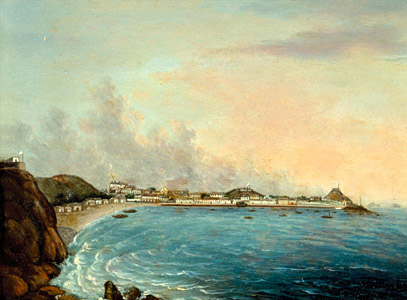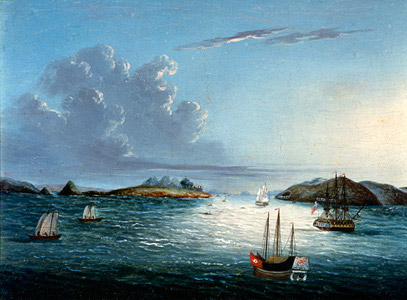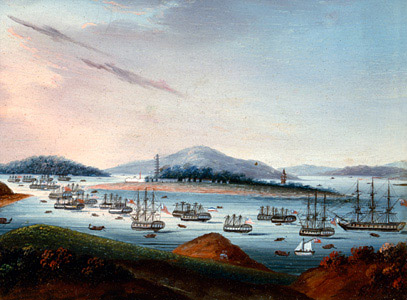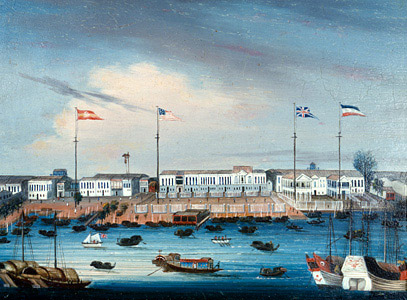| |
Bocca Tigris
Merchant ships began their entry to China at Macau, where they engaged a pilot to take them up the Pearl River to the anchorage at Whampoa. They could not make this perilous journey without Chinese help. Even the smallest foreign ships, of 400 tons, drew 18 feet of water, but the shoals in the Pearl River were shallower than this. Over time, as the ships grew in size, their draught increased to over 20 feet while the river became shallower over time. Only skilled Chinese pilots could calculate the time of the tides, avoid dangerous eddies, and follow the safe channel up the river. Every pilot was registered with the government. First the “outside pilots” guided the ship into Macau, then the registered Macau pilots took the ships upriver.
|
|
Journey Up the Pearl River Delta
|
 |
 |
 
Macau—Vessels heading for Canton first put in at this crescent shaped beach, the Praya Grande, at the mouth of the Pearl River. Here, they engaged a pilot and secured permission to navigate up the Pearl River. |
 
Bocca Tigris (Tiger's Mouth) is a narrow strait about 40 miles from the mouth of the Pearl River, where the breadth of the river shrinks from an average of 15 miles to two miles; several Chinese defensive forts were placed nearby. Ships stopped here to receive the mandarin’s “chop,” or seal, before proceeding. |
 |
 |
 |
 
Whampoa anchorage is 10 miles beyond Bocca Tigris and 10–16 miles from Canton. Here the merchants hired a Chinese agent, or comprador, to manage the needs of the ship and crew, and paid the customary taxes and bribes. Since Western sailing ships could not go beyond this area—the water was too shallow—sampans and other small craft ferried goods to Canton. |
 
Canton was the final destination for Western merchants, who could only live there during the four-month trading season. This view shows some of the foreign quarters, called factories or hongs. |
 |
 |
| |
These four 1810 paintings on copper form a set. In later versions,
Hong Kong replaced the Bocca Tigris view.
China, unknown artist(s)
[cwM_1810_M20533] [cwBTW_1810a_M20532]
[cwBTW_1810b_M20531] [cwC_1810d_M20530]
Peabody Essex Museum
|
|
| |
At Bocca Tigris (named from the Chinese word humen, or “tiger’s gate”), a narrow strait about 40 miles from the mouth of the river, two Chinese forts guarded the narrow passage, only two miles wide. The pilots had to show their permits before proceeding farther. They were only allowed to guide trading ships; warships, passenger ships, or ships carrying only bullion were prohibited. Beyond Bocca Tigris, the ships had to be towed by small sampans in order to hold them in the channel. It could take over 50 sampans to tow the largest ships.
|
|

Visualizing Bocca Tigris

|
| |
An honorary salute is exchanged between the Chinese forts and war junks (right), and two English embassy vessels (left), carrying ambassador Lord Macartney as they pass through Bocca Tigris traveling from Canton to Macau in 1794. Smoke emanates from the Lion (far left). The Jackall is next to her.
“The Forts of Anunghoy Saluting the Lion in the Bocca Tigris,” 1796
by William Alexander
Hong Kong Museum of Art [cwBTW_1796_AH914_BT]
|
|
| |
The Bocca Tigris forts turned out to be ineffective defenses against Western ships determined to pass them. In 1816, during a war scare, the British ship Alceste fired at the forts and silenced their guns immediately.
“Captain Sir Murray Maxwell in H.M. Ship Alceste Fires on the Chinese Fortresses at Bocca Tigris,” 1816
McLeod, artist, Dubourg, engraver
National Maritime Museum [cwSP_1816_nmm_PAF4865]
|
|
| |
In 1834 the British emissary Lord Napier, angered at Chinese official descriptions of him as a “barbarian,” forced his way up the river into Whampoa with two British warships on September 11, 1834. He died in China a month later. This was the opening of armed conflict between the British empire and China.
“HM Ships Imogene and Andromache passing the
Batteries of the Bocca Tigris”
by Thomas Allom
National Maritime Museum [cwSP_1834_nmm_BT_PU0244]
|
|
|

